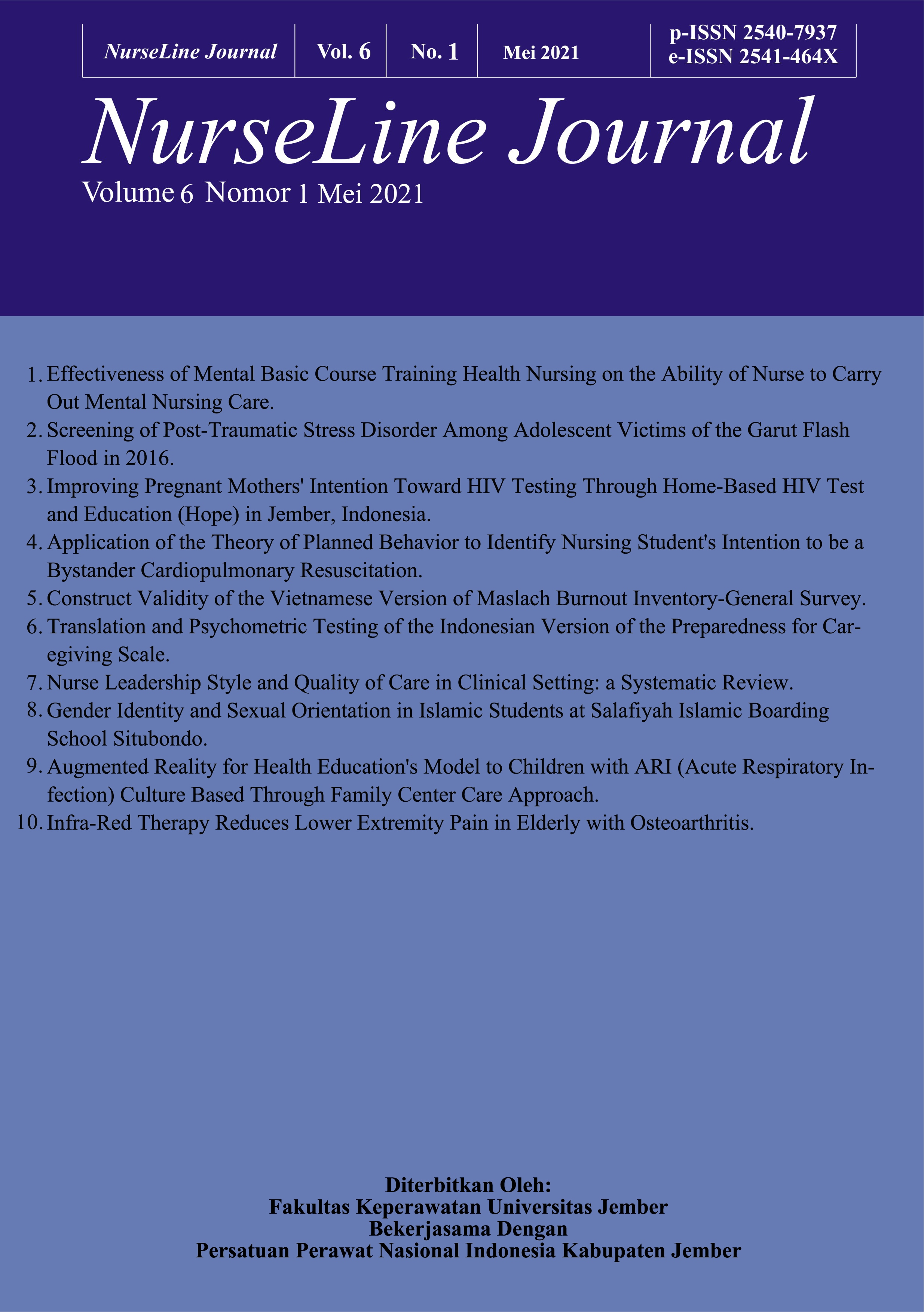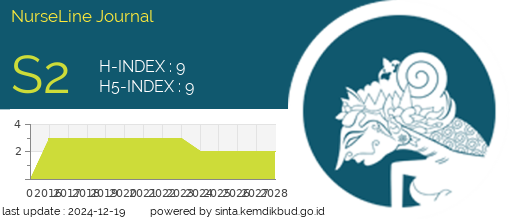Application of the Theory of Planned Behavior to Identify Nursing Student's Intention to be a Bystander Cardiopulmonary Resuscitation
DOI:
https://doi.org/10.19184/nlj.v6i1.19228Keywords:
Pre-hospital Emergency, Emergency Nursing, Bystander CPR, Out of Hospital Cardiac Arrest, OHCA, Theory of Planned Behavior, TPBAbstract
Background: Theory of Planned Behavior (TPB) is a social pshycological theory which explained that someone's tendency to behave is affected by their intention. This theory often used to predict behavioral intention in health workers by measuring some aspects such as attitude, subjective norm and self efficacy. As a prospective health worker who equipped with knowledge and skills about Cardiopulmonary Resuscitation (CPR) during education phase, nursing students are expected to have a good intentions to become bystander CPR in Out of Hospital Cardiac Arrest (OHCA).
Aims: This study intends to apply TPB in identifying factors that influence nursing student’s intention to perform bystander CPR.
Methods: This was a quantitative study with cross-sectional approach. The research population were undergraduate nursing student in Malang, while the 108 samples were taken using proportional sampling technique. Data were collected once using questionnaire included: attitude, subjective norm, self efficacy and intention to be a bystander CPR.
Results: Chi-square test revealed that the relationship between independent variables and intention to be a bystander CPR were: attitude p=0,00, self efficacy p=0,00 and subjective norm p=0,00. The result of multivariate analysis with logistic regression showed that: attitude p=0,004 (OR=5,279), subjective norm p=0,001 (OR=5,824) and self efficacy p=0,001 (OR=5,709).
Conclusion: There were significant relationship between attitude, subjective norm and self efficacy with intention, where subjective norm was the most dominant factor associated with intention of nursing student to be a bystander CPR.
Downloads
References
AIPNI. (2015). Kurikulum Inti Pendidikan Ners 2015. Retrieved February 15, 2017, from http://file:///C:/Users/Win7/Downloads/Final+Revisi+4+Juni+2015+Rancangan+Kurikulum+Ners.pdf.
Ajzen, I (2002). Residual effects of past on later behavior: Habituation and reasoned action perspectives" (PDF). Personality and Social Psychology Review, 6 (2), 107–122. doi:10.1207/s15327957pspr0602_02.
Ajzen. (2013). Theory of Planned Behaviour Questionaire: Measurement Instrument Database for The Social Science, Retrieved January, 17, 2017, from https://people.umass.edu/aizen/pdf/tpb.measurement.pdf.
Ajzen, I., & Fishbein, M. (2010). Predicting and Changing Behavior: The reasoned action approach. New York: Psychology Press.
Arafat, Y & Ibrahim, M. (2018). Social and Administrative Aspects of Pharmacy in Low and Middle Income Countries: The Use of Measurements and Health Behavioral Models to Improve Medication Adherence. Academic Press.
Boyle, M., Wallis, J., Suryanto. (2016). Time to Improve Prehospital Care in Developing country. Australasian Journal of Paramedic, 13(3). doi: 10.33151/ajp.13.3.538.
Chair et al. (2014). Public Knowledge and Attitudes Towards Cardiopulmonary Resuscitation in Hong Kong: Telephone Survey Introduction. Hong Kong Med, 20, 126–133. doi: 10.12809/hkmj134076.
Cooke, R., Dahdah, M., Norman, P., French, D. (2016). How Well Does The Theory of
Planned Behaviour Predict Alcohol Consumption?. Health Psychol. Rev. 10, 148–167. doi: 1080/17437199. 2014.947547.
Fishbein, M., & Cappella, J. N. (2006). The role of theory in developing effective health communications. Journal of Communication, 56 (s1), S1-S17.
Gonzi, G., et al. (2015). Correlation Between Quality of Cardiopulmonary Resuscitation and Self-Efficacy Measured During in-Hospital Cardiac Arrest Simulation; Preliminary results. Acta Biomed for Health Professions, 86(1), 40-45.
Hackman, C., Knowlden, A. (2014). Theory of Reasoned Action and Theory of Planned Behavior-Based Dietary Interventions in Adolescents and Young Adults: a Systematic Review. Adolescent Health, Medicine and Therapeutics, 6(5),101-14. doi: 10.2147/AHMT.S56207.
Kumari, M., Amberkar, M., Alur, S., Bhat, P., Bansal, S. (2014). Clinical Awareness of Do’s and Don’ts of Cardiopulmonary resuscitation (CPR) Among University Medical Students-A Questionnaire Study. Journal of Clinical dan Diagnosis Research, 8(7), 8-11. doi: 10.7860/JCDR/2014/8541.4567.
Ham, M., Jeger, M., & Ivkovic, A. (2015). The Role of Subjective Norms in Forming the Intention to Purchase Green Food. Economic Research-Ekonomska Istrajivanza, 28(1), 738-748. doi: 10.1080/1331677X.2015.1083875.
Hock et al. (2014). PAN-Asian Network Promotes Regional Cardiac Arrest Research: emergency physician international. Retrieved February 12, 2017, from http:// www.epijournal. com/article/129-pan-asian-network-promotes-regional-cardiac-arrest-research.
Hoffmann, T., Bennett, S., Del Mar, C. (2013). Evidence-based Practice Across the Health Professions. 2nd ed. Churchill Living Stone Australia: Elsevier.
Jeffreys, M. (2012). Nursing Student Retention: Understanding the Process and Making a Different. New York: Springer Publishing Company.
Lapkin, s., Jones, T., Giligan C. (2015). Using the Theory of Planned Behaviour to Examine Health Professional Students' Behavioural Intentions in Relation to Medication Safety and Collaborative Practice. Nurse Education Today 35, 935–940. doi: 10.1016/j.nedt.2015.03.018.
Lu et al.1 (2016). An Exploration of Attitudes Toward Bystander Cardiopulmonary Resuscitation in University Students in Tianjin, China: A survey. International Emergency Nursing, 24, 28–34. doi: 10.1016/j.ienj.2015.05.006.
Lu et al.2 (2016). Factor influencing university student’s willingness to performing bystander cardiopulmonary resuscitation. International emergency nursing. doi: 10.1016/j.ienj.2016.04.001.
Mattox, A.(2012). Strategies for Improving Patient Safety: Linking Task Type to Error Type. Circulation, 32(1), 52-78. doi: 10.4037/ccn2012303.
McDermott, M., Oliver, M., Simnadis, T., Beck, E., Coltman, T., Iverson, D., Caputi, P., Sharma, R. (2015). The Theory of Planned Behaviour and Dietary Patterns: a Systematic Review and Meta-Analysis. Prev. Med. 81, 150–156. doi:10.1016/j. ypmed.2015.08.020.
McEachan., Conner., Taylor., Lawton. (2012). Prospective Prediction of Health-Related Behaviors with The Theory of Planned Behavior: a meta-analysis. Health Psychol. Rev. 5, 97–144. doi: 10. 1080/17437199. 2010. 521684.
Mimiaga, M., Reisner, S., Reilly, L., Soroudi, N., Safren, S. (2009). HIV Prevention: Individual Intervention. Academic Press.
Ozbilgin et al. (2015). Evaluation of Public Awarness, Knowledge and Attitude About Cardiopulmonary Resuscitation: Report of Izmir. Turk J Anaesth Reanim, 43, 396-405. doi:10.5152/TJAR.2015.61587.
Panchal et al. (2015). An “Intention-Focused†Paradigm for Improving Bystander CPR Performance. Resuscitation, 88, 48–51. doi:10.1016/ j.resuscitation. 2014.12.006.
Ryan, S., Carr., A. (2010). Rheumatology: Applying the Biopsychosocial Model to The Management of Rheumatic Disease. Churchill Living Stone: Elsevier.
Sasson et al. (2013). Increasing Cardiopulmonary Resuscitation Provision in Communities With Low Bystander Cardiopulmonary Resuscitation Rates. Circulation.127,1-9. doi: 10.1161/CIR.0b013e318288b4dd.
Seaton, M., Marsh, H., Craven, R. (2010). Big-Fish-Little-Pond Effect: Generalizability and Moderation—Two Sides of The Same Coin. Am. Educ. Res. J. 47, 390–433. doi:10.3102/0002831209350493.
Smith, A. (2015). Attitude, Subjective Norm, and Perceived Behavioral Control as Indicators for Nurse Educators’ Intention to Use Critical Thinking Teaching Strategies: a Structural Equation Model Analysis. Michigan: Andrews University.
Talbot, A., Dorrian, J., Chapman, J. (2015). Using the Theory of Planned Behaviour to examine enrolled nursing students' intention to care for patients with alcohol dependence:A survey study. Nurse Education Today 35, 1054–1061. doi:10.1016/j.nedt.2015.05.017.
Wati, S., Wihastuti, T., Nasution, T. (2017). Analysis of Factors Affecting Behavioral intention of Nursing Student as Bystander Cardiopulmonary Resuscitation on Handling Out of Hospital Cardiac Arrest (OHCA) In Malang. Jurnal Ilmu keperawatan, 5(2), 230-239. E-ISSN: 2598-8492.
Yzer, M. (2012). Perceived Behavioral Control in Reasoned Action Theory: A Dual-Aspect Interpretation. The Annals of the American Academy of Political and Social Science 640(1), 101-117. doi: 10.1177/000271621142350









